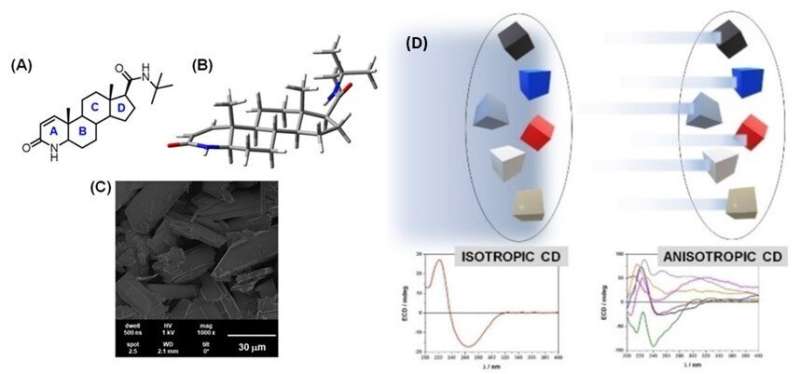Circular Dichroism beamline provides breakthrough in mapping chiral materials

A European research group has developed an exciting new imaging method on Diamond Light Source's beamline B23 that could improve the characterisation of chiral molecules in pharmaceuticals and other chiral molecules in the solid state. This pioneering work may have important impact on drug development and control of illegal substances by allowing the identification of a specific 'fingerprint' for each molecule.
Development of this important new tool was only made possible by the combination of Electronic Circular Dichroism (ECD) imaging together with the highly collimated microbeam generated at the Diamond B23 beamline which allowed higher spatial resolutions that were previously unattainable with earlier bench top instruments.
Optimizing the Circular Dichroism Imaging tool
Beamline B23 for Circular Dichroism at Diamond is a life sciences, chemistry and material science beamline for investigating and observing structural, functional and dynamic interactions in elements such as proteins, nucleic acids, nanoparticles and chiral molecules.
Circular Dichroism (CD) is an absorption spectroscopy technique that uses the differential absorption of left- and right-handed circularly polarized light to investigate the structure of chiral molecules. Electronic Circular Dichroism Imaging (ECDi) is one of the key techniques available to determine the configuration of small molecules, particularly chiral active pharmaceutical ingredients (APIs), and is now a vital tool in chemistry, physics and materials science providing unique information on chiral structures consisting of many molecules (supramolecular). Combining conventional CD instruments with synchrotron technology reduces the measurement time and amounts of sample material required for true chirality measurement and accurate identification of configuration. The new method should also be able to extract additional information from microcrystalline samples without the need for orientation of samples and single large crystals.
Harnessing the power of the synchrotron
In the new work, recently published in Chemistry—A European Journal, the team developed ECDi on the B23 beamline which enables the mapping of large sample surfaces at various spectral resolutions down to 0.01 mm2 because of the highly collimated micro light beam available on the beamline. Previously, measuring the ECD of solid samples with bench top ECD instruments meant that the structural information of small domains (<100 μm) was lost and additional spectral artifacts reduced the quality of data obtained. For the first time, researchers used the ECDi method on beamline B23 to characterize the chiroptical properties of pellets made from finely ground crystalline molecules to allow recognition of domains of different supramolecular structures of heterogeneous samples. Using previous bench-top instruments these would otherwise have appeared homogeneous due to their lower spatial resolution of 2–3 mm or more.
Developing the new technique on beamline B23
During the study, the research team mixed microcrystals of the active pharmaceutical ingredient finasteride (a medication used to treat benign prostatic hyperplasia in men and hair loss) with inert potassium chloride (KCl) which were then pressed to form solid samples.
The team recorded solid-state ECD (ss-ECD) spectra using the synchrotron radiation source at beamline B23. The results highlighted in much clearer detail the role and impact of local anisotropies (the quality of exhibiting properties with different values when measured along axes in different directions) in the solid state and demonstrated that the local signal is different from the whole sample signal. These local anisotropies were generated by the random orientations of the microcrystallites of the chiral sample mixed with KCl in the pellet and could only be detected by ECD imaging using the highly collimated microbeam generated at the B23 beamline allowing higher spatial resolutions unattainable with benchtop instruments.
For this measurement, the researchers focused the light beam to a diameter size of ⁓0.1 mm at the sample surface. They scanned the investigated sample area of 6 mm × 6 mm as a grid of 12 columns by 12 rows at intervals of 0.5 mm corresponding to 144 synchrotron radiation CD (SRCD) spectra scanned in the 200–400 nm wavelength range.
Implications for the future
An important result of this ECD imaging study is that the isotropic (the same values when measured in different directions) ECD measured on the whole pellet is the average of ECD spectra for all possible orientations meaning that the isotropic CD can be considered as a true chirality measurement and providing a type of ECD 'fingerprint' that can used for the assignment of the absolute configuration of chiral molecules.
The important findings from this study demonstrate that the observed isotropic solid-state ECD spectrum is governed by the anisotropy of locally oriented crystals which introduces a new level of quality for these measurements. The experimental ECDi data obtained using the highly collimated micro beam of B23 were in line with a theoretical approach for calculating isotropic CD and anisotropic ECD spectral components and this paves the way for the characterization of the chiroptical properties of chiral molecules in the crystal form.
Dr. Rohanah Hussain, Senior Beamline Scientist in the Soft Condensed Matter Village, and one of the authors of the new paper, says, "This introduces a new quality for solid-state ECD measurements and opens up a new future for probing and mapping chiral materials in the solid state such as active pharmaceutical ingredients (APIs) in pills or tablets in different pharmaceutical formulations and other structurally under-determined chemical entities."
The study authors concluded that this new ECD imaging technique could be extended to characterize the distribution of APIs in pills or tablets in different pharmaceutical formulations and, by applying the fingerprint concept, to find the producer of the active substance using a previously constructed database. They also suggested that the use of this new technology might be beneficial for controlling the traffic of illegal substances.
More information: Marcin Górecki et al, Electronic Circular Dichroism Imaging (ECD i ) Casts a New Light on the Origin of Solid‐State Chiroptical Properties, Chemistry – A European Journal (2021). DOI: 10.1002/chem.202103632
Journal information: Chemistry – A European Journal
Provided by Diamond Light Source


















